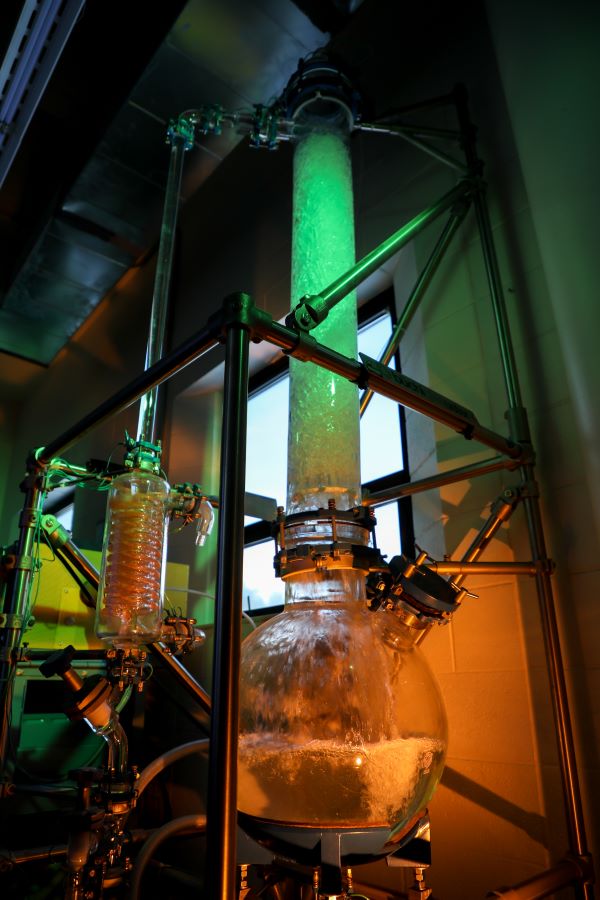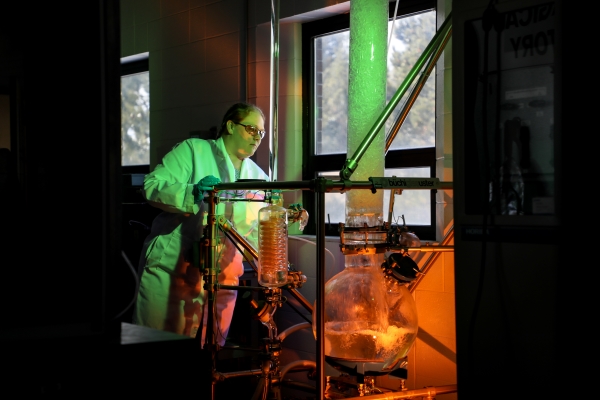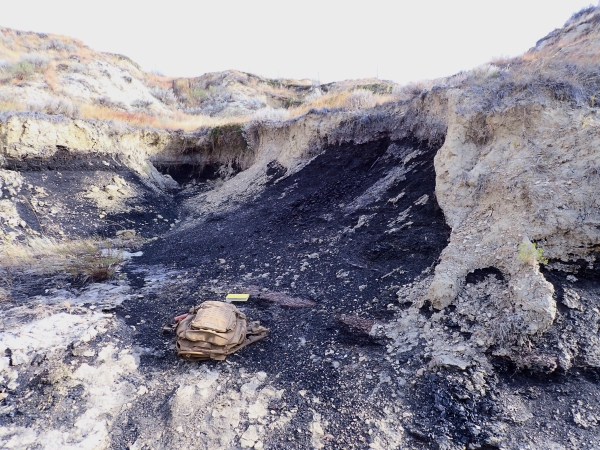MONTANA TECH RESEARCHERS AT FOREFRONT OF EFFORTS TO BRING RARE EARTH ELEMENT MINING, PROCESSING TO U.S. SHORES

Rare earth elements are critical components of smart phones, flat screen televisions, computers, newer light bulbs, hybrid and electric car batteries, and pieces of laser- and precision-guided missile technology essential to U.S. defense agencies. Thus, in 2023, it is hard to imagine a world in which these "behind the scenes" rare earth elements don't play a major role.
But when a mining geologist named Frank A. Crowley from the Montana Bureau of Mines and Geology (a department of Montana Technological University) documented the presence of rare earth elements in the Sheep Creek area of Ravalli County in 1960, he noted that the primary uses of rare earth elements at the time were limited. Instead aggressive exploration was done in the area for niobium, an element that was increasingly used after World War II for jet engine and gas turbine parts, stainless steel manufacturing, vacuum tubes, and in nuclear reactor shield material.
"In the 1960s, rare earth elements were interesting, but it is not what they were looking for," said Dr. Christopher Gammons, Professor in Montana Tech's Department of Geological Engineering. "Now the current owners are busy reevaluating the old prospect pits and tunnels for rare earth elements and other critical minerals."
Gammons is focusing on the unique geology of rare earth elements in Montana, along with graduate student Sarah Risedorf. The pair took samples from old adits in the Sheep Creek area last summer. Those samples were sawn and polished so that a scanning electron microscope could confirm the elemental composition of each sample. They found significant concentrations of rare earth elements in their samples. "Some of the minerals we've encountered have only been found in two or three places globally," Gammons notes.
This work is attracting the attention of rare earth investors. US Critical Materials Corp. announced in 2022 that they planned to invest $10 million to explore 54 lode claims in the Bitterroot National Forest. In February 2022, US Critical Minerals put out a press release noting that 37 samples taken in 2022 were confirmed to have 17.13% total rare earth elements.
"These sample results continue to validate our investments and confirm that Sheep Creek is one of the highest-grade rare earth projects in the U.S.," said Darren Collins, Chief Executive Officer and Director of US Critical Minerals Corp. "We are particularly encouraged that all carbonatite samples detected rare earth mineralization along with the identification of new carbonatites for additional follow-up work."
Gammons will be back in the area this summer, when the company might drill to gain more information. He and his students are also moving on to other areas of interest in the Sapphire and Bitterroot Mountains where elevated concentrations of rare earth elements are known or suspected to occur.
His team plans to work with stable isotopes to date the samples and try to figure out how old the geologic formations are, and how they formed. Other deposits of rare earth elements exist in Alberta, British Columbia, and near Lemhi Pass in Idaho.
"We don't know how these deposits relate to each other," Gammons said.
Right now, Gammons says the limited extent of the Sheep Creek rare earth elements means they would likely be selectively mined unless the deposits are found to be more widespread in the area.
The tricky part about rare earth elements is not just finding them.
"Even if concentrations of rare earth elements are high, you don't know if they can be separated," Gammons said. "The first thing you want to do to figure that out is to go see the metallurgist."
Much of the university's current research in rare earths is funded by the Department of Defense. In January 2022 the DEVCOM Army Research Laboratory (ARL) provided Montana Tech with a $5 million research and development award through a Cooperative Agreement, enabling ARL and Montana Tech to work closely together to investigate ways to enable the development of a stable national supply chain for rare earth elements. This award could be extended for at least four additional years with a possible ultimate value of $25 million.

This joint ARL–Montana Tech research program will use Montana as a "model" for identifying, mapping, exploring, extracting, and processing rare earth elements in the United States in innovative and environmentally responsible ways. The program consists of 14 individual projects, 7 that focus on exploration of possible sources of rare earths within Montana, and 7 that focus on methods of advanced processing of rare earths in an environmentally friendly way. The exploration activities involve projects by both academic researchers and staff from the Montana Bureau of Mines and Geology. This award builds on a separate active Cooperative Agreement with ARL (similar in size and currently in its third year) to develop advanced materials for the protection and support of the warfighter. The relationship between ARL and Montana Tech dates to 2014, when ARL first enabled Montana Tech to work on advanced rare earth element processing methods. This research funding by ARL through the years has boosted Montana Tech's capability to carry out significant research in areas critical to both the nation's defense and civil sectors. "With Senator Jon Tester's support, our relationship with ARL has deepened over the years, leading to significant growth in Montana Tech's research infrastructure," said Dr. Ronald White, Professor and Director of the Center for Advanced Materials Processing. Dr. White has been the Principal Investigator on all the university's cooperative agreements with ARL and he further stated, "Montana Tech is a very different research university today from the campus that I joined almost ten years ago."
Dr. Jerome Downey, Goldcorp Professor of Extractive Metallurgy, with his team of graduate students and research associates, are the metallurgists tasked with figuring out how to separate rare earth elements from ore.
"All of what we do will be high risk, high reward research," Downey said.
Most of the extractive processes that have been invented thus far are very specific to each deposit of rare earth elements, based on the properties of each individual mineral deposit and the unique combination of rare earth elements and gangue.
The team in Downey's lab is working on a five-step process done at high temperatures that would allow for extraction of rare earth elements from various feedstocks of either ore or mineral concentrations taken from recycled materials.
"If any of these individual steps do not work out, it's not a zero-sum game," Downey said. "Each of the other steps are still significant, but together it would be a major breakthrough in rare earth processing."
Step 1 of the process has been published, but Steps 2–5 are high-heat methods that are highly confidential, and the team anticipates filing provisional patents in the upcoming weeks.
Downey's team is also testing a separate hydrometallurgy method that uses a magnetic coil and nanoparticle technology to remove metals from solution. As part of her doctoral research, Dr. Teagan Leitzke demonstrated the efficacy of the method by successfully extracting metal ions from various samples including local river waters, and the research team wants to see if it might be a viable way to extract rare earth elements from solution generated by leaching the product of Step 1 of the pyrometallurgy process.
Both of the pyrometallurgical and hydrometallurgical processes the team is evaluating will be much more environmentally friendly than processes currently in use.

"The byproducts we would be producing are going to be substantially less harmful," Downey said. As Downey's team works toward what they hope will be a breakthrough, U.S. officials are eyeing increasingly bellicose relations with China that are underscored by a sobering fact: China has a near-monopoly on many parts of the rare earth supply chain.
The Mountain Pass Mine in California has long been the only rare earth mine in the U.S., and its mined product is shipped overseas to China, where the only processing facilities exist. The U.S. Department of Defense awarded $35 million to MP Materials in February 2022 to build a processing facility at the Mountain Pass Mine. Another rare earth mine is expected to come online in far west Texas in 2023, with processing facilities planned to come online in the Lonestar State as well.
According to compiled data, in the 1980s, the U.S. was a leading producer of rare earth elements. As of 2020, the U.S. imported 80 percent of its rare earth elements directly from China, with China owning interest in rare earth mines in other countries as well.

In 2010, the world saw how China's near-monopoly of a mineral supply could be detrimental to adversarial nations when China suspended shipments of rare earth metals to Japan for several weeks, after a dispute over a fishing trawler's collision with a coast guard vessel.
United States federal defense officials have, in recent years, written and spoken about the "Great Power Competition" or "Era of Strategic Competition," which marks a struggle for dominance among the U.S., China, and Russia. Securing domestic and non-adversarial supply lines for critical minerals and rare earth elements play a key piece in the national security experts' objectives.
The process Chinese mines have used to extract rare earth elements from ore involves using ammonium sulfate as a leaching agent. It is a process that involves a lot of toxins, and if rare earth elements are to be mined in the United States, it would be preferable to have a more environmentally friendly method, as mentioned above.
"Around 30% of the total environmental costs of rare earth element mining can come from this," Assistant Professor of Mechanical Engineering Richard LaDouceur noted.
LaDouceur works with biochar, the charcoal-like material left behind when organic material burns. As part of the greater rare earth elements project, he's working to see if biochar could be used in resonant vibratory separation mixers to separate rare earth minerals.
"The main issue is how similar they are," LaDouceur said. "It makes them incredibly difficult to separate. We're working on some novel separation techniques."
LaDouceur also noted that most of the cost of rare earth element mining operations is tied up in separation equipment, meaning a better process might be able to help reduce the cost of production.
The Rare Earth Elements projects at Montana Tech are working to leave no stone unturned as they explore how to more economically and safely produce rare earth minerals domestically.
That is why Associate Professor Ryan Davison, of the Montana Bureau of Mines and Geology, plans on spending the next few years traveling across eastern and central Montana. Studies have shown that coal contains rare earth elements. The U.S. Department of Energy released a map of coalbeds with known rare earth element concentrations in 2017, but much of Montana's potential was unknown.
"My specific task is to see what Montana has in terms of rare earth in coal," Davison said. "One of the biggest problems with that is that we don't really know what we have. In the early 1900s people were looking at coal, so we have it pretty well mapped, but back then they were looking at it as an energy source."
Davison is taking samples from deposits mapped so long ago that some of the documents he uses reference wagon trails that date back to the late 1800s and early 1900s.
"A lot of the early work that the guys did in the 1930s, 40s, and 50s has been really helpful," Davison said.
Other researchers in the rare earth elements study group are focusing on how to extract the materials from ore and bring them to market. The elements are also present in coal ash, and one project is exploring whether they could be concentrated from power plant refuse. Some projects the Montana Bureau of Mines and Geology is focusing on involve exploring mining brownfields in Maxville, Melrose, and other like areas for promising mineralization.
The past ten years of ARL-funded research has positively impacted the economy of the University. More than $619,000 has gone to undergraduate student wages, with another $663,000 going to graduate tuition. Faculty wages have been increased by $2,345,000, and nearly $5,871,000 has gone to purchasing major research equipment (e.g., $882,000 was used to purchase a scanning electron microscope, with another $250,000 allocated to x-ray diffraction equipment). As a result of the funding, equipment, and expertise on campus, the University has been able to provide services to external clients in dozens of states and countries around the world.
At the University's Public Lecture Series in February, the Montana Bureau of Mines and Geology's Economic Geologist Kyle Eastman (M.S. Geoscience, '17) noted the importance of the university's connection with the greater community. At Montana Tech's recent job fair, Eastman said nearly every employer he encountered was on the hunt for engineers.
"They are saying, 'we're struggling to find geologists, petroleum engineers, metallurgical and environmental engineers," Eastman said.
While he understands why younger students might be pulled toward fields like artificial intelligence, which created a buzz this spring with the release of ChatGPT and other open AI chatbots, he made a strong case for STEM students to consider careers in extracting the minerals and elements required to run the high-tech infrastructure.
"None of this is as important as training the next generation of explorers in the U.S.," Eastman said. "If we cannot train the next generation of problem solvers, economic geologists, and mining engineers, then the game is over."